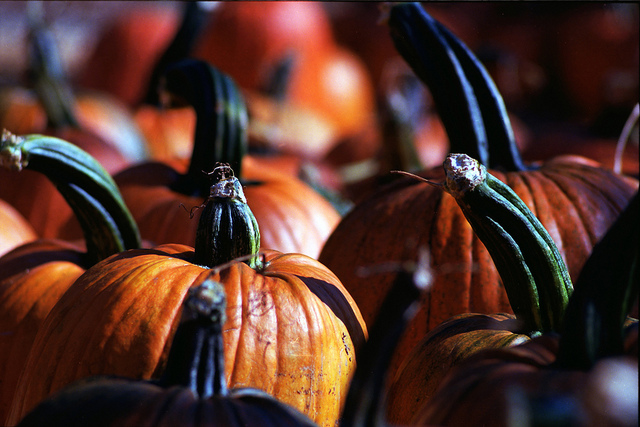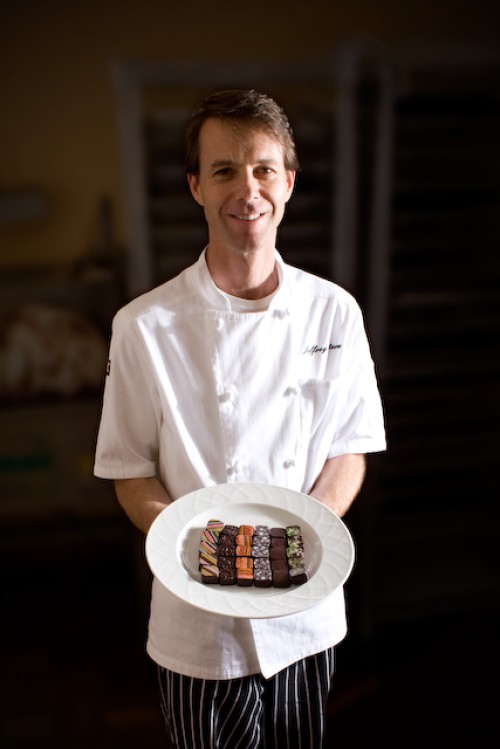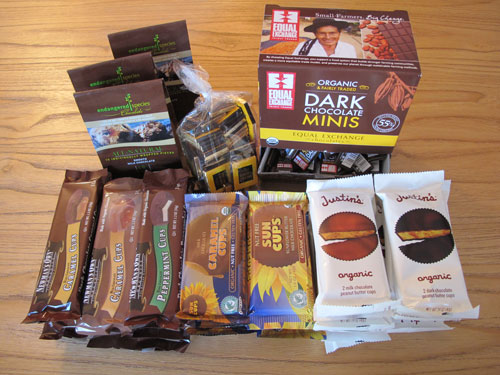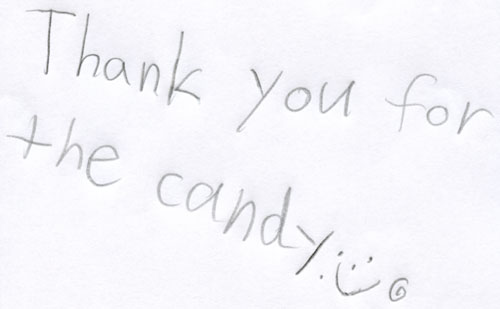Bittersweet Notes and The Root: Chocolate’s Bittersweet Legacy

Halloween pumpkins at the field by DeusXFlorida
This morning, The Root published a piece I wrote entitled Chocolate’s Bittersweet Legacy. In the article, I detail labor abuses in West African cacao cultivation, the chocolate industry’s decades long inaction on the problem, and recommended responses for consumers who want to make a difference. I hope that you’ll check it out.
Two related posts on my blog are:
- Ethical Halloween Candy 2011, which offers a comprehensive list of fairly traded alternative Halloween chocolate candies with recommendations on where to buy and price comparisons, and
- Ethical Halloween Candy 2011 Taste Test Results, which details the results of a taste test survey of many of these fairly traded candies.
If you’re not familiar with The Root, I also recommend browsing through some of the other articles and blogs when you visit the site. It’s a leading source of online news and commentary from an African American perspective and one of my regular reads.
Happy Halloween!
Ethical Halloween Candy 2011 Taste Test Results

Trick or Treat! by Jason Paluck
A few weeks ago, I posted a long list of ethical Halloween chocolate candy alternatives. Because these alternative candies are unfamiliar to many, I sent samples out to a small army of kid and adult taste testers to ask their opinions. My goals were to get a sense for how kids and adults react to candy that is new and different and to see if they would even like these lesser known ethical alternatives.
In short, there’s good news. Our tasters ranked several fairly traded alternative candies superior to traditionally popular brands lacking ethical sourcing. Some concerns were raised about availability, package design, candy size, and price points, but the results of this taste test were largely successful.
The totally-unscientific-yet-super-delicious survey design went something like this:
I sent the survey out to 8 families, 24 people total. Each family received 5-6 types of candy to try. I asked each person in the family to rate each candy as “Yummy,” “OK,” or “Gross.” I also included a few questions:
- “How does this candy compare to other peanut butter cups/milk chocolate squares/peppermint patties that you’ve had?”
- “Do you like the packaging?”
- “Is the candy too big or too small for Halloween?”
- “What is your favorite candy that you tried today?”
- “What is your favorite candy in the whole world?”
Kids included in the survey ranged in age from 2 to 10. I sent it to kids who can’t get enough sugar, kids who would choose a chicken drumstick over a candy bar any day, kids who don’t like chocolate, kids who eat mostly pickles, and kids who can’t stand peanut butter. Adults ranged from 25 to, well, let’s say over 50. (*wink*) The adults were a mix of the candy apathetic and self professed chocoholics, some firmly in the milk chocolate camp and others insisting that only dark can satisfy their needs.
Here’s what we learned.
On the plus side:
- Unsurprisingly, everyone was excited to try this candy. One survey respondent, upon learning that the candy was en route, wrote: “Nom nom nom. Excitement building.”
- The simple act of participating in this survey got people talking about ethical chocolate in a way that they hadn’t before. Several parents commented on their children’s shocked reactions to the problem of forced, trafficked, and child labor in West Africa. One proud father wrote: “We absolutely tried ALL the chocolates — loved most of it…. AND we are buying ETHICAL Halloween candy this weekend from Whole Foods!!” Another parent explained that his six year old daughter felt so strongly about the issue that she took it upon herself to organize the family’s tasting and to tell all of her friends at school to look for fair trade candy from now on.
- Every family reported back that this was a fun exercise in taste, marketing, and ethics to enjoy as a group. “It really gets you thinking about the chocolate that we buy out of habit and what other chocolate we might just pass by,” explained one participant. One family even suggested that their kids, while typically reluctant to try new things, were excited enough about the tasting event that they happily ripped into everything with gusto.
- We also found candies that survey respondents preferred to their Hershey’s counterparts. Yum! More on the favorites below.
However, there were some challenges:
- Both kids and adults reported difficulty in comparing the taste of ethical candy alternatives to better known traditional candies. A mother of two wrote that, while often delicious, the candies were just plain different: “It is difficult to rate the candy because unfortunately we compare it to well know commercially sold candy that has been around forever.”
- Several adult survey respondents were concerned about price. “We sometimes have over 100 trick-or-treaters,” one participant told me, “so we have to keep costs as low as possible.”
- Several kids reported back that they didn’t find the packaging for the ethical candies to be very fun. A ten year old respondent and his mother said that some of the candy packaging “could use a facelift.” Another parent described the majority of the candy packaging as “boring and unappealing.”
- There were negative taste ratings on certain candies. Taste is an individual, subjective affair, and one product can’t please everyone all of the time. In addition, it goes to show that even when candy is ethically sourced, quality production and excellent taste are not a guarantee. More on the taste disappointments follows.
The absolute favorite candies were, in order of popularity:
- Justin’s Nut Butter Peanut Butter Cups: Several survey respondents ranked these among “the best peanut butter cups” they had ever had, and all but a few rated them significantly higher than Reese’s peanut butter cups. Parents wished that the candies were available in single servings as opposed to doubles.
- Equal Exchange 55% minis: Almost all survey respondents absolutely loved these; only a few of the kids found the chocolate to be “a bit bitter.” One young lady carefully practiced her newly mastered penmanship, writing “The Equal Exchange is awesome.” The adult tasters said that they enjoyed the complexity of chocolate, even identifying flavors of “cinnamon, caramel, and other spices.” Most kids said that these candies were too small, while most adults said that they were perfectly sized for trick-or-treaters. Go figure.
- Endangered Species Milk Chocolate Halloween Treats: These candies were widely popular among both kids and adults, with many people remarking that they found them “not too sweet,” and “refreshingly less sweet than Hershey’s.” The packaging, however, did not appeal to many.
- Newman’s Own Organics Peanut Butter Cups: These peanut butter cups came in at a close second to Justin’s and were a big crowd pleaser. Most parents agreed that they would prefer to buy these candies as singles, rather than in the usual package with three cups.
Among almost all adults and a few adventurous kids, the Michel Cluizel, Pralus, and Askinosie were extremely popular. Several of the adults, having tried these brands for the first time, said that they would seek them out in the future, intending to have them on hand for when they “need a serious chocolate fix.” One mother described the Cluizel as “some of the most complex chocolate I have ever had.” Another survey participant could not wait to try more of the single origin bars from Pralus and Askinosie. These three brands, while perhaps not widely known at a major commercial level, are from well respected high quality chocolate makers, so this does not come as a surprise.
The Newman’s Own Organics Peppermint Cups and Caramel Cups and Sun Cups Caramel and Sunflower Chocolate Cups were all well liked by more than half of the survey respondents, but were subject to individual taste preferences. For example, some participants do not like peppermint or caramel with chocolate. Those who liked them shared the refrain “We want more!” Others said that they enjoyed the Sun Cups Sunflower Chocolate Cups, but that, because they have the option, they prefer to eat peanut butter cups instead.
Some candies were ranked as needing improvement:
- Sun Cups Mint Chocolate Cups: Most survey respondents described these candies as too sweet and found the peppermint oil flavor too strong. The chocolate was criticized for being grainy, with a poor texture.
- Divine 70% Dark Chocolate Bites: Most survey respondents found the chocolate flavor in these bars to be too intense, with a long and somewhat unpleasant aftertaste. They also described the texture as “too waxy.”
(Note: We didn’t get to try all of the candies on the list due to time and budget constraints. I can say from personal experience, though, that I have previously enjoyed Sjaak’s, Chuao Chocolatier, and Sweet Riot’s tasty treats. They certainly merit further exploration in chocolate tasting adventures.)
All in all, this was a fun and educational exercise. Thanks so much to the wonderful survey participants — to the wicked awesome kids who so graciously suffered through the eating of ridiculous amounts of candy to help me out, and to the kind, patient parents who supervised the filling out of the surveys and the resulting sugar highs. You’re the best!
Update (October 31, 2011): Visit The Root to read more of my thoughts on this topic: Chocolate’s Bittersweet Legacy.
Happy Halloween!
Alexander and the Terrible, Horrible, No Good, Very Bad Halloween, by Jennifer Doody

Halloween by hanna horwath
The Halloween season often brings fond memories of tasty candy, fun costumes, and spooky nights. For author Jennifer Doody, it holds another significance altogether. In today’s guest post, Jennifer offers a tale of Halloween candy anguish and misfortune, an important reminder of the cultural differences that inform our tastes starting at a very young age.
————————————————————————————————————————–
Alexander and the Terrible, Horrible, No Good, Very Bad Halloween, by Jennifer Doody
Many years ago, my American family moved to Munich, Germany so my mother could pursue a career as an opera singer. My parents’ decision to not live on the nearby Army base was a deliberate one: as then-aspiring artists, progressives and intellectuals, they were determined that their four-year-old daughter would be immersed in this new and rich culture.
In the fall of my first year of school, my parents invited a boy from my German kindergarten class, Alexander Härting, to join us for Halloween. Back in the 1970s, cultural globalization wasn’t as widespread as it is now: aside from the Army bases, the only evidence of America’s presence was, of course, the golden arches of McDonald’s. Alexander had never heard of Halloween or the ritual of trick-or-treating, but his mother readily agreed, and once we threw together a standby cowboy costume for him, we were ready to go.
As Halloween wasn’t celebrated in Germany, we headed to the Army base to go door-to-door. At the first house, Alexander cautiously held out his bag, glancing over at me to make sure he was doing it right, and murmured a wary “Twick or tweet.” The woman smiled broadly and threw a huge candy bar into his bag, and another into mine. Alexander’s eyes, I remember, went as big as saucers: chocolate in Germany was much more of a special treat, something to be savored, and was often distributed in individual pieces. To have a six-ounce block of chocolate simply tossed into his waiting hands, not just once, but over and over, was the culinary equivalent of winning the World Cup.

Halloween Candy by slgckgc
When our bags sagged with sweet treasures, we returned to my parent’s apartment, where — in the finest American tradition — we dumped all our candy out onto my bed and tore into it greedily. Alexander grabbed the biggest candy bar of Hershey’s chocolate, tore off the wrapper, and bit into it with relish. He chewed joyfully, and then his face sagged, and he burst into tears.
It wasn’t his fault: he was used to German chocolate, of course. I munched pensively on my Snickers bar as he howled in outrage at the universe’s cruelty and betrayal. Shortly thereafter, his mother shamefacedly bundled him up and took him home, as no amount of cajoling or consolation could stop him from weeping. Thirty years later, it’s still the best visual image I have of instantaneous heartbreak and devastating disillusionment.
According to the Chocolate Museum in Cologne, as early as 1877, German chocolatiers set strict purity laws for their chocolate. The restrictions were meant to “protect their products from imitations and introduce binding quality restrictions.” In 1973, Germany was among the 50 countries to sign the first cocoa agreement, led by the International Cocoa and Chocolate Organisation (ICCO). America, the world’s greatest consumer of chocolate, declined.
Today, chocolate made in Germany must meet strict requirements for cocoa: 60% for dark chocolate, 50% for mild dark chocolate, 30% for whole milk chocolate, and 25% of milk chocolate (white chocolate — my personal favorite, although that’s another post! — is not required to contain cocoa mass at all, only cocoa butter). At the turn of the 20th century, Germany led all cocoa-consuming countries with “19,242 tonnes of processed cocoa beans… or 380 grams of cocoa beans were consumed per person annually.” In 2007, Germany ranked sixth in chocolate consumption, with each person in Germany eating 9.32 kg per year (the Irish were first, with each person in Ireland consuming 11.85 kg per year, followed by the Swiss, English, Belgians and Norwegians).
Every Halloween, I think of Alexander, and thank him for providing me with the best visual example of disillusion and despair –- not to mention the irrefutable realization that life is sometimes terribly, horribly, brutally unfair –- that I’ve ever witnessed. But I can’t blame him. To this day, when I’m traversing the streets of Boston and need a chocolate fix, I may make do with American chocolate in a pinch… but what I’m really craving is the creamy, “milk from the Alps” texture of Milka, or the rich diversity of Ritter Sport.
————————————————————————————————————————–
Jennifer Doody is a writer with 20 years experience in university news, communications, and academic editing, based in Boston, Massachusetts. Visit her professional site here to read more of her work.
Interview with Jeffrey Stern, chocolatier and chocolate advocate in Quito, Ecuador
Jeffrey Stern is a chocolatier, chocolate advocate, entrepreneur, and blogger based in Quito, Ecuador. I recently asked Jeff to answer a long list of questions about his life and work, and he was kind enough to oblige. Below, in the first half of this interview, Jeff details the missions of his companies and his educational and work background (which, I should note, left him singularly well prepared for his current work). He also explains many of the challenges that small batch production chocolatiers face in relation to direct trade, marketing, and domestic/international bureaucracy, as well as the travel and learning opportunities that forever changed the way he tastes and understands chocolate.

Photo courtesy of Jeffrey Stern
Interview with Jeffrey Stern, Part 1, October 2011
Carla Martin (CDM): What is the focus of your two companies, and what are their missions?
Jeffrey Stern (JS): The focus of my Ecuador based company, Gianduja Chocolate, is to provide high quality, sophisticated bonbons and chocolate products for the local market, using almost all local ingredients. I use only Ecuadorian chocolate, local fruits, cream, and butter, and the only imported items I use are those not available here like transfer sheets, real vanilla, and colored cocoa butters.
My other company, Aequare Fine Chocolates, had as its original mission the goal of importing, wholesaling, and retailing to the United States fine chocolates made in Ecuador with top quality Ecuadorian chocolate. Also, I made it a point of this company to have contact with and knowledge of the chocolate and its origins from bean to final product. I knew the grower of the beans and how he managed his farm, I knew the factory and operations where the chocolate was made, and of course I made the final chocolates myself. We imported into the United States and retailed through the website and worked with a few brokers. Ultimately, the idea was to add value to cacao in the country of origin, and have direct trade relationships with all our suppliers here in Ecuador.
Unfortunately, I think the story was somehow not compelling enough for consumers and what I envisioned as an artisan product being made in Ecuador simply ended up being perceived as another consumer packaged good once it was in the US. Sort of a “lost in translation” problem, as well as the difficulty of explaining a “direct trade” story when you don’t have a multimillion dollar marketing campaign behind the product(s), a big PR budget, etc.
Also, the lack of any US physical presence and someone who could do tastings and trade shows made it difficult to get the product exposure. I think if I had had a physical location somewhere that would have helped a lot. Finally, I see the whole marketing system in the US as such a giant machine, with brokers, distributors, etc. It’s really hard to get your product recognized and noticed, as well as costly if you want to do trade shows. Because the US market and system is so massive, I see it as causing an unfortunate disadvantage for the consumer who, despite the increasing growth and interest in artisan and handmade foods, remains highly disconnected from foods’ origins. And with chocolate, coming all the way from a far off country, it’s even harder to establish and tell a compelling story that offers the authenticity and traceability that consumers often want.
CDM: What are the primary activities of your chocolate and cacao education and training services?
JS: Primarily, I work with companies outside of Ecuador who usually know nothing about the country or the cocoa trade, and want to source either cacao from Ecuador or a semi-processed product such as cacao liquor or powder, or want to have a cacao-based product contract manufactured in Ecuador. I have also worked with artisan bean to bar companies who are looking to source cacao beans from Ecuador. Finally, I act as a “chocolate expert” for chocolate tours — these can be either groups who just have a casual interest in chocolate, or professional groups. I am currently working with three tour operators in Ecuador offering 3-5 day tours centered around chocolate activities, including visits to artisan chocolate makers, visits to plantations, fermentation and drying centers, brokers, and chocolate tastings. I have also been hired to work as a chocolate expert for a well known online chocolate school which will be offering a professional tour in June of next year for chocolatiers and bean to bar chocolate makers.
CDM: How were your companies started?
JS: I moved to Ecuador with my wife and family in May of 2007, with the intention of opening my chocolate business. I had lived in Ecuador from 1994 to 1995, first while getting my Master’s in Community and Regional Planning, and then returned to work for USAID after graduating. I then traveled to Ecuador almost annually until 2007. I got the idea of starting the chocolate business several years after I changed careers (2001, when I attended culinary school). We did some test marketing in trips to Ecuador in 2005 and 2006, and found there was a good market for chocolate. I founded my other company, Aequare, in 2008, with the intention of exporting chocolates from Ecuador. After our first year here, I realized the market wasn’t as big as I had initially expected, and decided to export.
CDM: How are your companies structured, and how many employees work with the companies?
JS: Our local company in Ecuador, Gianduja Chocolate, is a sole proprietorship. I am the chocolatier, my wife takes care of administration and accounting, and I have one employee who knows about 80% of what I do. My other company is an LLC. I am the only employee. When the need arises, I occasionally hire an additional person, but due to very onerous labor laws in Ecuador which make part-time or hourly payment nearly impossible, it’s rare.
CDM: What is your educational background and training?
JS: I have a Bachelor’s in Latin American Studies from New York University and a Master’s Degree in Community and Regional Planning from the University of Texas at Austin. I am also a 2001 graduate of L’Academie de Cuisine in Gaithersburg, Maryland, where I earned a degree in culinary arts.
CDM: What type of work were you involved in before beginning these companies? Was it related to or unrelated to chocolate?
JS: My first career after college and graduate school was primarily in foreign aid; specifically, I spent several years working with USAID based in Ecuador. I also worked with a consulting firm in Washington, DC for one year that was focused primarily on World Bank, Inter-American Development Bank, and USAID projects. I spent two years in Nicaragua working in population and health programs with USAID as well. None of the work was related to chocolate.
After completing my culinary training, I worked in restaurants, catering operations, and as a personal chef. I later worked in a chocolate shop part-time.
CDM: What are some of the challenges that you have encountered while running your businesses?
JS: Ecuador’s environment, both on the private sector side and the public (government) side is all about friction. There seems to be a genuine lack of cooperation — it sounds amusing, but it’s not.
While getting permits and paperwork for operating has gotten a little bit more transparent in recent years, things still seem very arbitrary and ambiguous. It used to be that you had to hire an “expediter” to get almost anything done — that’s doublespeak for someone who you pay to grease the wheels of bureaucracy and issue you permits in a timely fashion. Now you can get many permits directly yourself, but the amount of time and money involved makes it just as costly as if you had hired the expediter.
When you go to an agency, be it the Municipality, the tax agency, the Ministry of Health, you can get one answer one day, and the next day you go back with the same question, and you’ll get an entirely different answer. You get the feeling that nobody really knows the rules, and that they’re being made up as things move along. So you never are really sure if you’re doing things right. It’s very frustrating and unnerving.
On the private sector side, there are difficulties in getting paid. No one uses the mail here, and messenger services only occasionally. Electronic payments are the exception, not the rule. Most companies pay from 2pm-4pm on Friday afternoons at their offices. So if you can’t make it to pick up your check, you have to wait another week to get paid. Fortunately, I have enough business now and a unique product that allows me to have a “cash only — take it or leave it” policy. That is, if you want the product, it’s cash or check on delivery, with few exceptions only for longstanding clients.
There’s very little collaboration or cooperation among similar types of businesses to help each other out. For example, there is no organization or association in Quito of chocolate makers who might attempt to work together for publicity or other ends to grow the market cooperatively for their products. Businesses jealously guard their secrets. I call this an economy of scarcity, not abundance, and thus, because even information is scarce, no one shares it. I think in the long run it’s detrimental to business, and while this is a broad generalization, I think the lack of trust and cooperation is one of the factors that hinders economic growth.
CDM: How do you keep up to date with new developments in chocolate?
JS: I mostly use the web to learn about what is going on in the chocolate world. Here in Ecuador, I have regular contact with people in the cacao and chocolate industry from growers to manufacturers of chocolate and semi-processed products such as liquor and powder. We have recently formed a group of professsional industry people involved in chocolate at all points in the supply chain called the “Academia de Chocolate,” which is another forum for sharing and gathering information.
CDM: Why chocolate? What about it is fascinating to you?
JS: I got interested in chocolate when I started working part-time in a chocolate shop. I hadn’t really gotten a good understanding of how to work with chocolate in culinary school, so I got some books and started to study on my own. There are very few sources that clearly explain what tempering chocolate actually is; when I was finally able to read about the polymorphism of cocoa butter and how temperature affects crystal formation in chocolate, I was able to wrap my head around it. Not only does chocolate taste good, of course, but it’s a fascinating substance to work with.
After almost 5 years in Ecuador in the chocolate business, my knowledge has expanded far beyond just the technical know-how of chocolate making. I have knowledge of bean to bar operations, identifying quality cacao, import/export operations, and how the cacao industry works in Ecuador.
CDM: What was your “aha” moment in relation to chocolate?
JS: I never really understood what chocolate was and how its flavor was developed until I actually went to a plantation and tasted several chocolate liquors (pastes) made on the spot from beans. When I tasted various liquors side by side from beans from different areas, with different fermentation, I suddenly realized just how important the beans are and just how different beans with different fermentations, roasts, etc can be. It was like a light bulb went on in my head — a total epiphany. Now when I taste chocolate I have a much better picture in my head (or taste map, however you’d call it) of what’s good or off about a chocolate’s flavor than I ever did before.
——————————————————————————————————————————–
Visit Jeffrey Stern’s blog here to learn more about his adventures with chocolate just south of the equator, and follow his company Gianduja Chocolate on his website and on Facebook. Also, stay tuned for Part 2 of this interview, as well as details on Jeff’s upcoming Kickstarter campaign — he is currently working to launch a direct trade project to promote Ecuador’s heritage Nacional cacao and benefit small farmers.
Update (November 8, 2011): Part 2 of the interview can be read here.
Wacky World of Choc Wednesdays: Alinea’s Chocolate, Pumpkin Pie
Read:
Achatz and his team at Alinea have earned the position as best restaurant in North America for staying ahead of the curve and constantly being innovative. As a diner, when you sit down for that mutli-course meal, you want your mind blown. This new dessert, dubbed “chocolate, pumpkin pie,” was inspired by the film The Cook, The Thief, His Wife & Her Lover. Even as a mere viewer, you will have your mind blown. Just watch.
via Eater Chicago
Watch:






